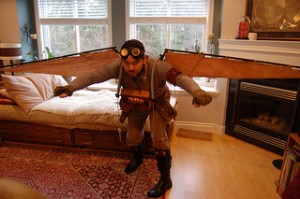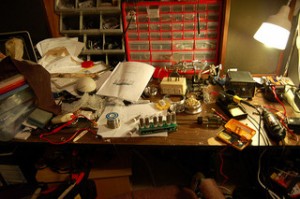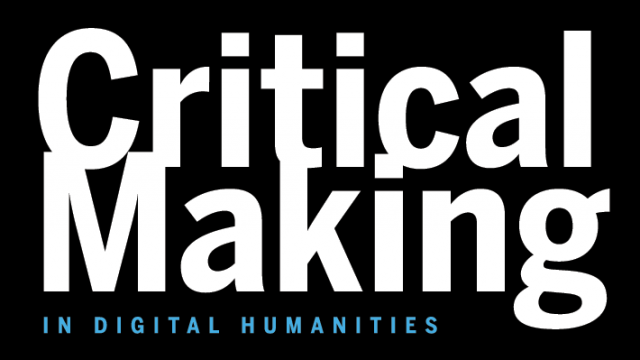Captain Chronomek
PIs: Theresa Tanenbaum, Simon Fraser University; Karen Tanenbaum, UC Santa Cruz
Collaborators: Allen Bevans, Electronic Arts; Jim Bizzocchi, Alissa Antle, Ron Wakkary, and Audrey Desjardins, Simon Fraser U; Amanda Williams, Fabule Fabrications and Wyld Collective; Kate Compton, UC Santa Cruz
Awards: Best Costume at Vancouver Maker Faire, Featured in the “Powered by Fiction” exhibit at the 2012 Emerge Conference at ASU
Site: http://tf.thegeekmovement.com/wp/?page_id=40
Steampunk imagines a fictional history for technology dominated by Victorian aesthetics, engineering, materials, and techniques (Onion, 2008). It is rooted in a number of cultural expressions including its own literary canon, music scene, and fashion sensibility. However, it is the centrality of maker practice within the Steampunk community and its highly politicized and ideological negotiations of post-modern and Victorian values that make the subculture so interesting. As a critical making practice, Steampunk draws on utopianist design fictions (Bleecker, 2009; Sterling, 2009)from its literary cannon and a political ethos grounded in punk attitudes (Carrott & Johnson, 2013) to imaginatively remediate contemporary technologies (Tanenbaum, Tanenbaum, & Wakkary, 2012).
As part of our critical making practice, we developed a character called “Captain Chronomek”, a time-traveling Steampunk superhero who himself has a maker/tinkerer bent. The genesis for Captain Chronomek was a superhero-themed student design competition at the Tangible, Embedded and Embodied Interaction Conference (TEI) in 2011. Chronomek is a man out of time, a Victorian-era mechanic pulled from his own period and granted time-traveling powers. With access to technology from across all of time, Chronomek is the ultimate maker/hacker, cobbling together what he needs from all of human (and even non-human) history. In this way, Chronomek encapsulates the dual fascinations of the Steampunk movement: the romanticized past and the never-quite-realized utopian future.

The design process for creating the character was one of continual iteration between the concept and the physical artifacts; the character was shaped by the technology and material we had on hand. A feedback loop was established between the physical creation, the theoretical explorations of Steampunk practice and design fiction, and the ideation around the fictional world. From a methodological standpoint, this type of Critical Making owes much to the epistemological practices employed in contemporary arts and practice-as-research (Nelson, 2006).

Steampunk reacts against the rise of minimalist “flat” industrial design in hardware and software by returning to the brass, leather, and wood handcrafted materials of the past; it resists the proliferation of “black box” technologies and closed systems by exposing technology as an aesthetic element in its own right. We see within Steampunk subculture the perception of an impending “crisis” for late-stage capitalist and industrial societies, beyond which it is difficult to perceive a stable future. This is one of the core contradictions that underlies the ideology of Steampunk: although the genre celebrates an era in which mass production and assembly were coming of age, it resists traditional narratives of industrialization that prize uniformity and homogeneity (Tanenbaum, Desjardins, & Tanenbaum, 2013).
Bleecker, J. (2009). Design Fiction: A Short Essay on Design, Science, Fact and Fiction (Vol. 2011).
Carrott, J., & Johnson, B. D. (2013). Vintage Tomorrows: A Historian and a Futurist Journey Through Steampunk into the Future of Technology. O’Reilly.
Nelson, R. (2006). Practice-as-research and the Problem of Knowledge. Performance Research, 11(4), 105–116.
Onion, R. (2008). Reclaiming the Machine: An Introductory Look at Steampunk in Everyday Practice. The Journal of Neo-Victorian Studies, 1(1), 138–163.
Sterling, B. (2009). The User’s Guide to Steampunk. Steampunk Magazine, 1(5), 30–33.
Tanenbaum, T. J., Desjardins, A., & Tanenbaum, K. (2013). Steampunking Interaction Design: Principles for Envisioning Through Imaginitive Practice. Interactions, 20(3), 28–33.
Tanenbaum, T. J., Tanenbaum, K., & Wakkary, R. (2012). Steampunk as Design Fiction. In CHI 2012 (pp. 1583–1592). Austin, Texas: ACM Press.
